The Electricity Generation Landscape of Bioenergy in Germany
Abstract
1. Introduction
2. Input Data
2.1. Plant Dataset
2.2. Load Factor
2.3. Verification Data
3. Simulation Model
4. Investigation Results
4.1. Simulation Results
4.2. Bioenergy Landscape
5. Conclusions
Funding
Data Availability Statement
Acknowledgments
Conflicts of Interest
Abbreviations
| TSOs | Transmission System Operators |
| ReSTEP | Renewable Spatial-Temporal Electricity Production |
| CERN | European Organization for Nuclear Research |
| CEMDR | Core Energy Market Data Register |
| SMARD | Electricity Market Data for Germany |
| BNetzA | Bundesnetzagentur |
| CSVs | comma-separated values |
| GIS | Geographic Information System |
| MAE | Mean Absolute Error |
| RMSE | Root-Mean-Square Error |
References
- IRENA. Renewable Energy Statistics 2024; International Renewable Energy Agency (IRENA): Abu Dhabi, United Arab Emirates, 2024; Available online: https://www.irena.org/publications (accessed on 21 August 2024).
- Zeitreihen zur Entwicklung der Erneuerbaren Energien in Deutschland Unter Verwendung von Daten der Arbeitsgruppe Erneuerbare Energien-Statistik (AGEE-Stat); Umweltbundesamt (UBA): Dessau-Roßlau, Germany, 2024; Available online: https://www.umweltbundesamt.de (accessed on 16 April 2024).
- Rauner, S.; Eichhorn, M.; Thrän, D. The spatial dimension of the power system: Investigating hot spots of Smart Renewable Power Provision. Appl. Energy 2016, 184, 1038–1050. [Google Scholar] [CrossRef]
- Baasch, S. Energy transition with biomass residues and waste: Regional-scale potential and conflicts. A case study from North Hesse, Germany. J. Environ. Policy Plan. 2021, 23, 243–255. [Google Scholar] [CrossRef]
- Lehneis, R.; Manske, D.; Schinkel, B.; Thrän, D. Spatiotemporal Modeling of the Electricity Production from Variable Renewable Energies in Germany. ISPRS Int. J. Geo-Inf. 2022, 11, 90. [Google Scholar] [CrossRef]
- Millinger, M.; Tafarte, P.; Jordan, M.; Hahn, A.; Meisel, K.; Thrän, D. Electrofuels from excess renewable electricity at high variable renewable shares: Cost, greenhouse gas abatement, carbon use and competition. Sustain. Energy Fuels 2021, 5, 828–843. [Google Scholar] [CrossRef]
- Harnisch, F.; Lehneis, R. The power grids need to be made ready for a circular and bio-based economy. Next Sustain. 2023, 2, 100010. [Google Scholar] [CrossRef]
- Lauer, M.; Dotzauer, M.; Millinger, M.; Oehmichen, K.; Jordan, M.; Kalcher, J.; Majer, S.; Thraen, D. The Crucial Role of Bioenergy in a Climate-Neutral Energy System in Germany. Chem. Eng. Technol. 2023, 46, 501–510. [Google Scholar] [CrossRef]
- Welfle, A.; Thornley, P.; Röder, M. A review of the role of bioenergy modelling in renewable energy research & policy development. Biomass Bioenergy 2020, 136, 105542. [Google Scholar] [CrossRef]
- Jin, E.; Sutherland, J.W. An integrated sustainability model for a bioenergy system: Forest residues for electricity generation. Biomass Bioenergy 2018, 119, 10–21. [Google Scholar] [CrossRef]
- Liu, W.-Y.; Lin, C.-C.; Yeh, T.-L. Supply chain optimization of forest biomass electricity and bioethanol coproduction. Energy 2017, 139, 630–645. [Google Scholar] [CrossRef]
- Steubing, M.; Dotzauer, M.; Zakaluk, T.; Wern, B.; Noll, F.; Thraen, D. Bioenergy plants’ potential for contributing to heat generation in Germany. Energy Sustain. Soc. 2020, 10, 14. [Google Scholar] [CrossRef]
- Akhtari, S.; Sowlati, T. Hybrid optimization-simulation for integrated planning of bioenergy and biofuel supply chains. Appl. Energy 2020, 259, 114124. [Google Scholar] [CrossRef]
- Hauser, E.; Wern, B. The role of bioenergy in the German “Energiewende”—Whose demands can be satisfied by bioenergy? Energy Sustain. Soc. 2016, 6, 35. [Google Scholar] [CrossRef]
- Szarka, N.; Eichhorn, M.; Kittler, R.; Bezama, A.; Thrän, D. Interpreting long-term energy scenarios and the role of bioenergy in Germany. Renew. Sustain. Energy Rev. 2017, 68, 1222–1233. [Google Scholar] [CrossRef]
- Lehneis, R.; Manske, D.; Thrän, D. Modeling of the German Wind Power Production with High Spatiotemporal Resolution. ISPRS Int. J. Geo-Inf. 2021, 10, 104. [Google Scholar] [CrossRef]
- Lehneis, R.; Thrän, D. Temporally and Spatially Resolved Simulation of the Wind Power Generation in Germany. Energies 2023, 16, 3239. [Google Scholar] [CrossRef]
- Lehneis, R.; Manske, D.; Thrän, D. Generation of Spatiotemporally Resolved Power Production Data of PV Systems in Germany. ISPRS Int. J. Geo-Inf. 2020, 9, 621. [Google Scholar] [CrossRef]
- Lehneis, R.; Thrän, D. In 50 Shades of Orange: Germany’s Photovoltaic Power Generation Landscape. Energies 2024, 17, 3871. [Google Scholar] [CrossRef]
- Lehneis, R.; Harnisch, F.; Thrän, D. Electricity Production Landscape of Run-of-River Power Plants in Germany. Resources 2024, 13, 174. [Google Scholar] [CrossRef]
- Manske, D.; Schmiedt, J. Geo-Locations and System Data of Renewable Energy Installations in Germany [Data Set]; Version V20230420; Zenodo: Genève, Switzerland, 2023. [Google Scholar] [CrossRef]
- Core Energy Market Data Register, Bundesnetzagentur für Elektrizität, Gas, Telekommunikation, Post und Eisenbahnen, Bonn, Germany. Available online: https://www.bundesnetzagentur.de/EN/Areas/Energy/CoreEnergyMarketDataRegister/start.html (accessed on 9 February 2025).
- Online Portal of the Core Energy Market Data Register, Bundesnetzagentur für Elektrizität, Gas, Telekommunikation, Post und Eisenbahnen, Bonn, Germany. Available online: https://www.marktstammdatenregister.de/MaStR (accessed on 9 February 2025).
- Manske, D.; Grosch, L.; Schmiedt, J.; Mittelstädt, N.; Thrän, D. Geo-Locations and System Data of Renewable Energy Installations in Germany. Data 2022, 7, 128. [Google Scholar] [CrossRef]
- SMARD–Strommarktdaten, Stromhandel und Stromerzeugung in Deutschland 2020, Bundesnetzagentur für Elektrizität, Gas, Telekommunikation, Post und Eisenbahnen, Bonn, Germany. Available online: https://www.smard.de/home (accessed on 19 January 2022).
- Olauson, J.; Bergkvist, M. Modelling the Swedish wind power production using MERRA reanalysis data. Renew. Energy 2015, 76, 717–725. [Google Scholar] [CrossRef]
- Brecl, K.; Topič, M. Photovoltaics (PV) System Energy Forecast on the Basis of the Local Weather Forecast: Problems, Uncertainties and Solutions. Energies 2018, 11, 1143. [Google Scholar] [CrossRef]
- Benth, F.E.; Ibrahim, N.A. Stochastic modeling of photovoltaic power generation and electricity prices. J. Energy Mark. 2017, 10, 1–33. [Google Scholar] [CrossRef]
- Ekström, J.; Koivisto, M.; Mellin, I.; Millar, R.J.; Lehtonen, M. A Statistical Modeling Methodology for Long-Term Wind Generation and Power Ramp Simulations in New Generation Locations. Energies 2018, 11, 2442. [Google Scholar] [CrossRef]
- Ho, L.T.T.; Dubus, L.; De Felice, M.; Troccoli, A. Reconstruction of Multidecadal Country-Aggregated Hydro Power Generation in Europe Based on a Random Forest Model. Energies 2020, 13, 1786. [Google Scholar] [CrossRef]
- Thaker, J.; Höller, R. Hybrid model for intra-day probabilistic PV power forecast. Renew. Energy 2024, 232, 121057. [Google Scholar] [CrossRef]
- Manske, D.; Lehneis, R.; Thrän, D. The landscape of the renewable electricity supply - Municipal contributions to Germany’s energy transition. Renew. Energy 2025, 240, 122172. [Google Scholar] [CrossRef]
- Aliabadi, D.E.; Chan, K.; Jordan, M.; Millinger, M.; Thrän, D. Abandoning the Residual Load Duration Curve and Overcoming the Computational Challenge. In Proceedings of the 2022 Open Source Modelling and Simulation of Energy Systems (OSMSES), Aachen, Germany, 4–5 April 2022; pp. 1–6. [Google Scholar] [CrossRef]
- Pfenninger, S.; Hawkes, A.; Keirstead, J. Energy systems modeling for twenty-first century energy challenges. Renew. Sustain. Energy Rev. 2014, 33, 74–86. [Google Scholar] [CrossRef]
- Mundu, M.M.; Nnamchi, S.N.; Sempewo, J.I.; Uti, D.E. Simulation modeling for energy systems analysis: A critical review. Energy Inform. 2024, 7, 75. [Google Scholar] [CrossRef]
- Ramirez Camargo, L.; Nitsch, F.; Gruber, K.; Valdes, J.; Wuth, J.; Dorner, W. Potential Analysis of Hybrid Renewable Energy Systems for Self-Sufficient Residential Use in Germany and the Czech Republic. Energies 2019, 12, 4185. [Google Scholar] [CrossRef]
- Lehmann, P.; Gawel, E.; Meier, J.N.; Reda, M.J.; Reutter, F.; Sommer, S. Spatial distributive justice has many faces: The case of siting renewable energy infrastructures. Energy Res. Soc. Sci. 2024, 118, 103769. [Google Scholar] [CrossRef]
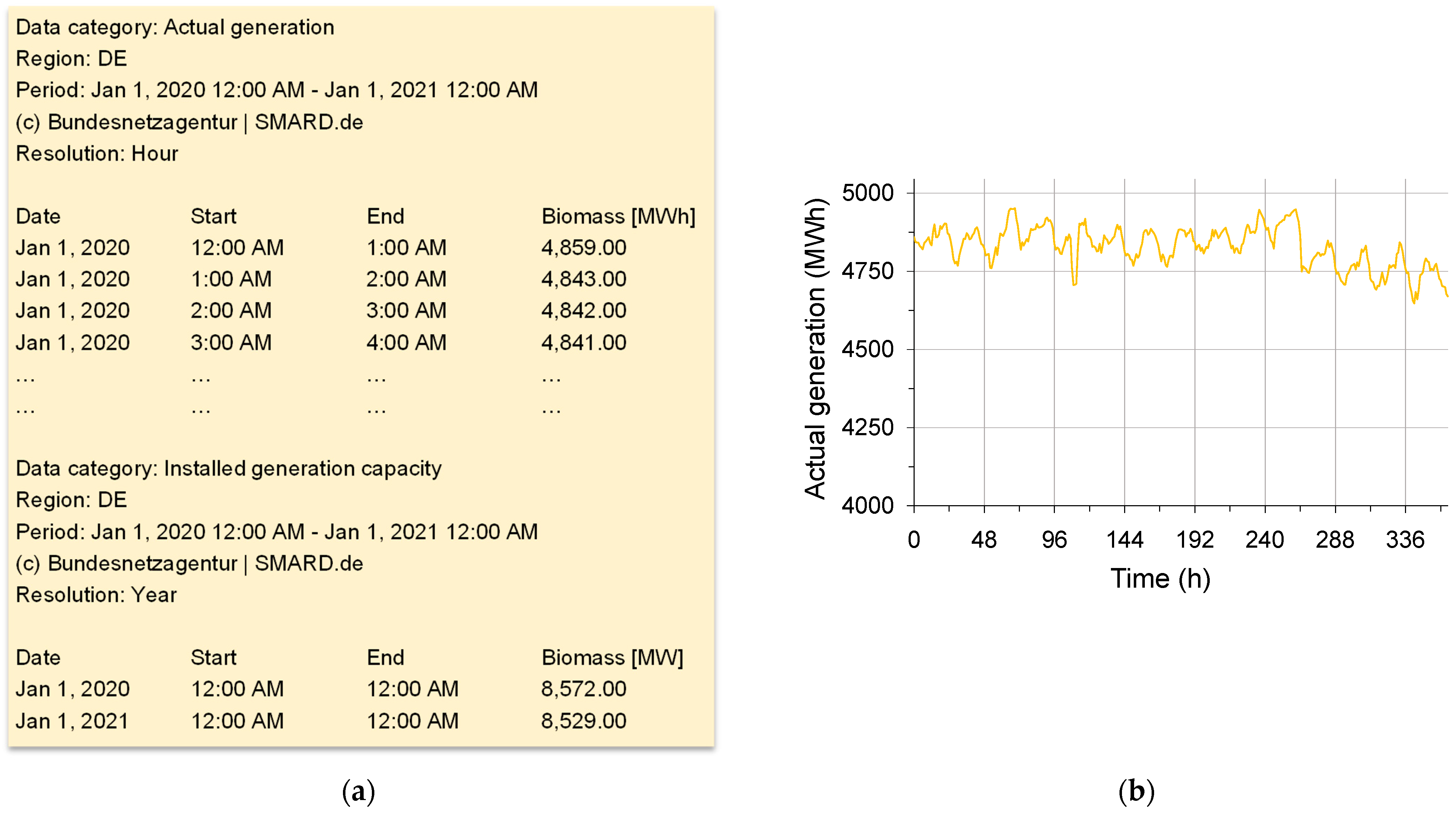
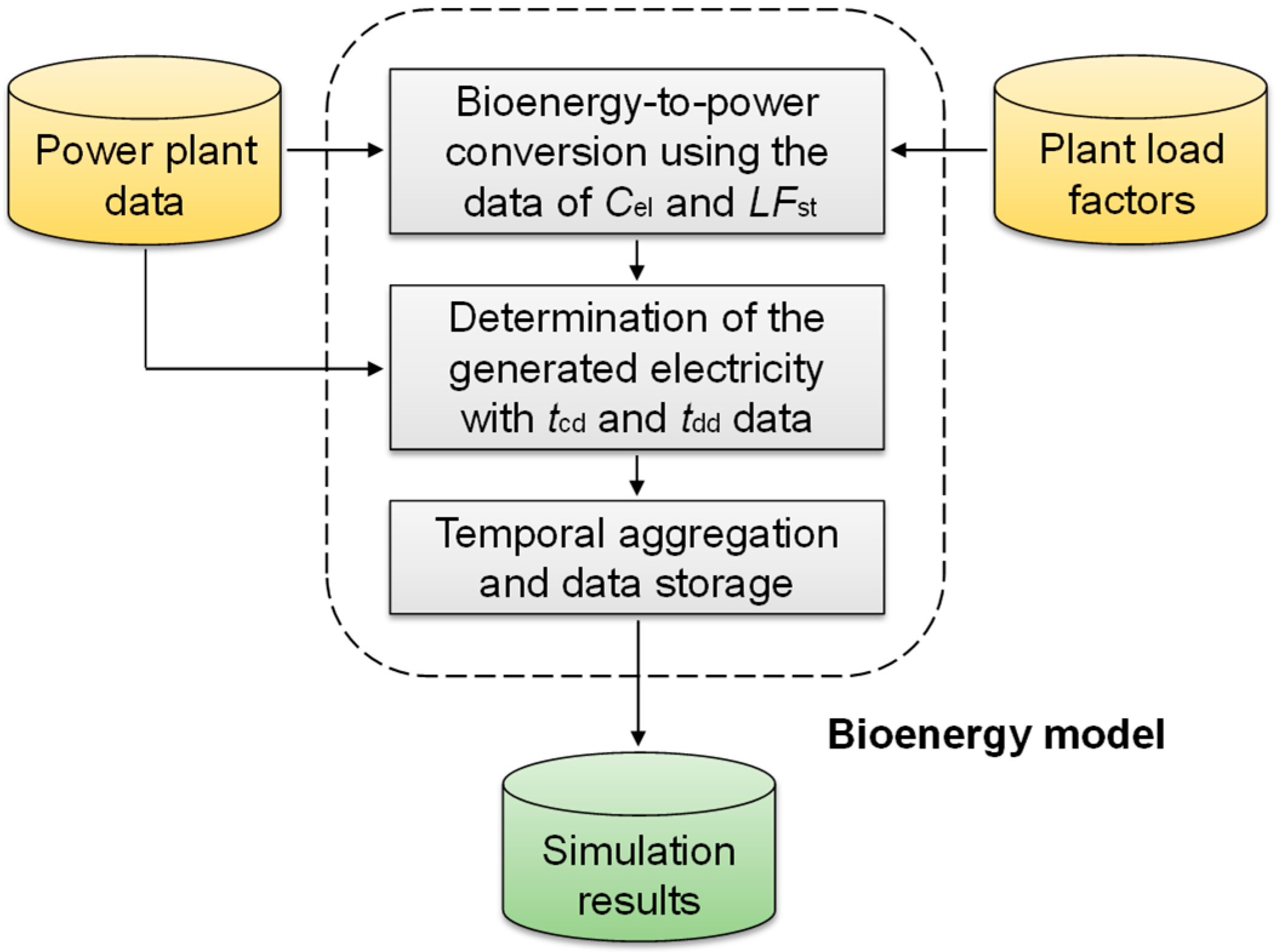
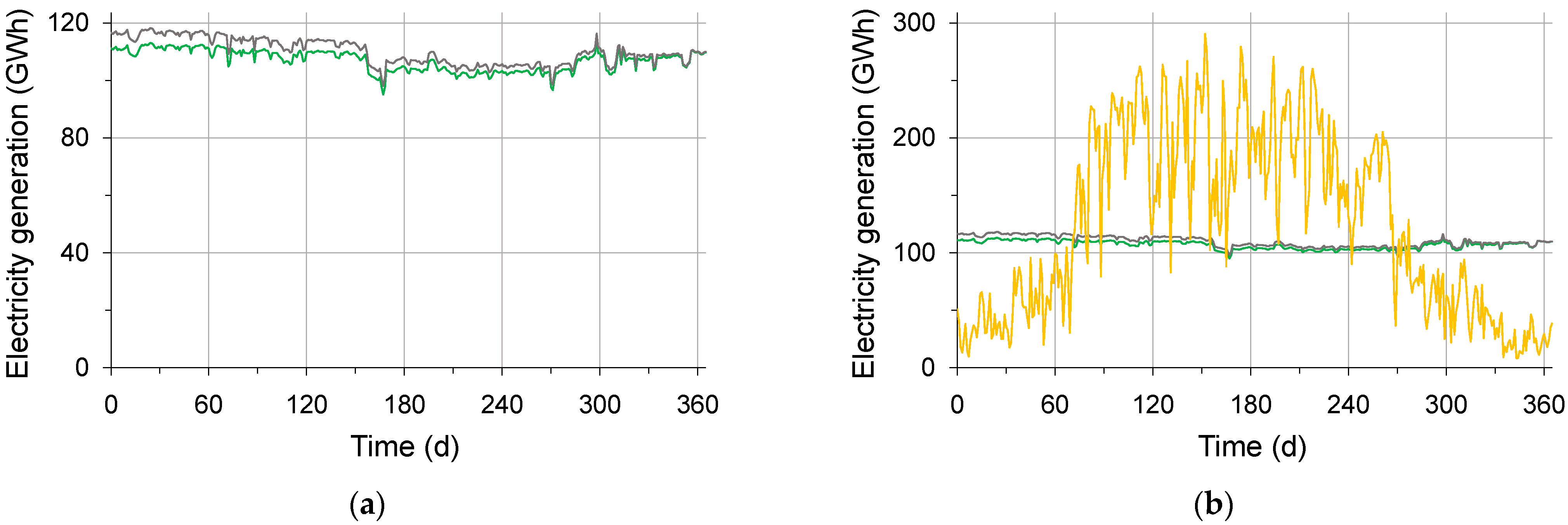

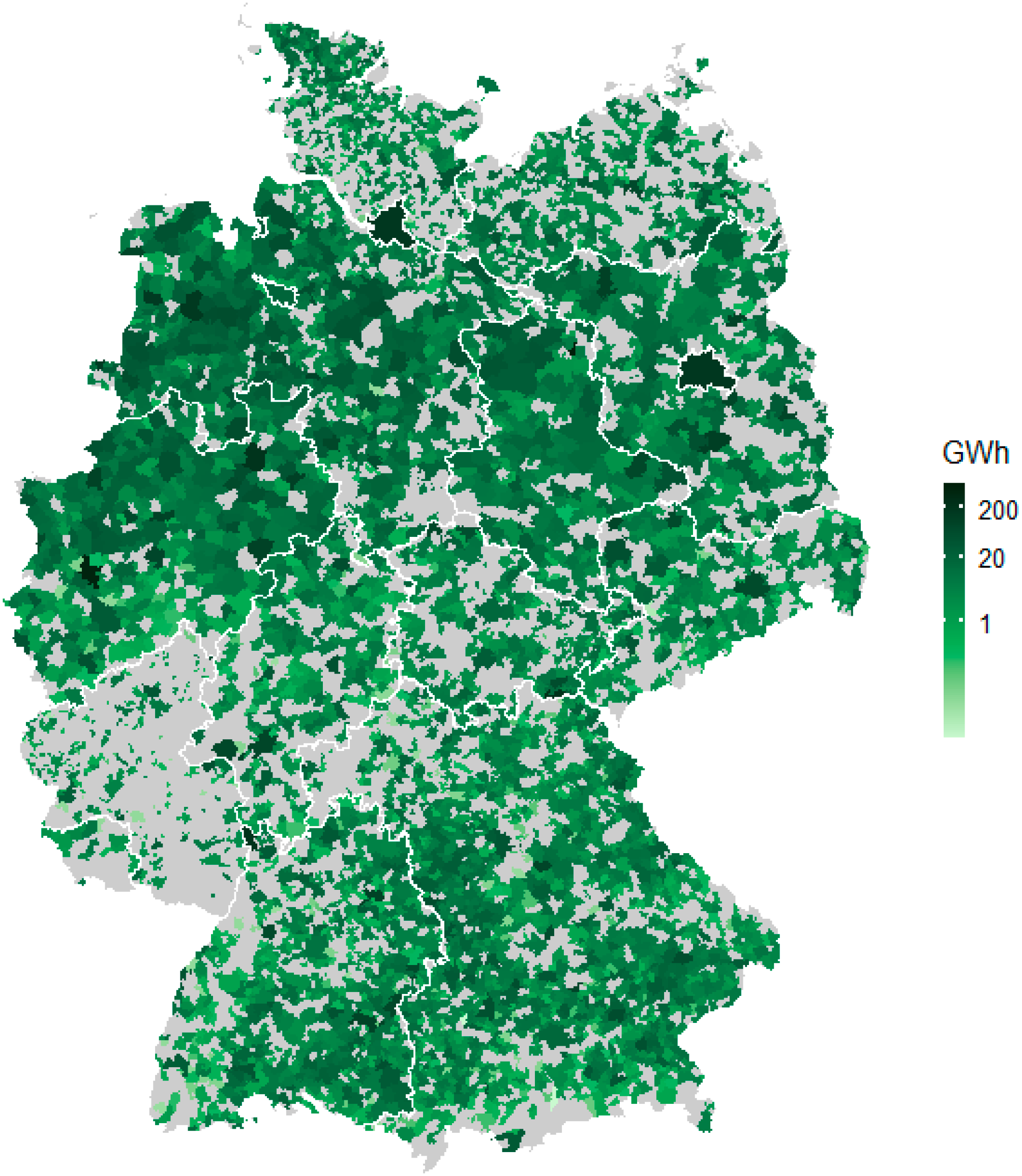
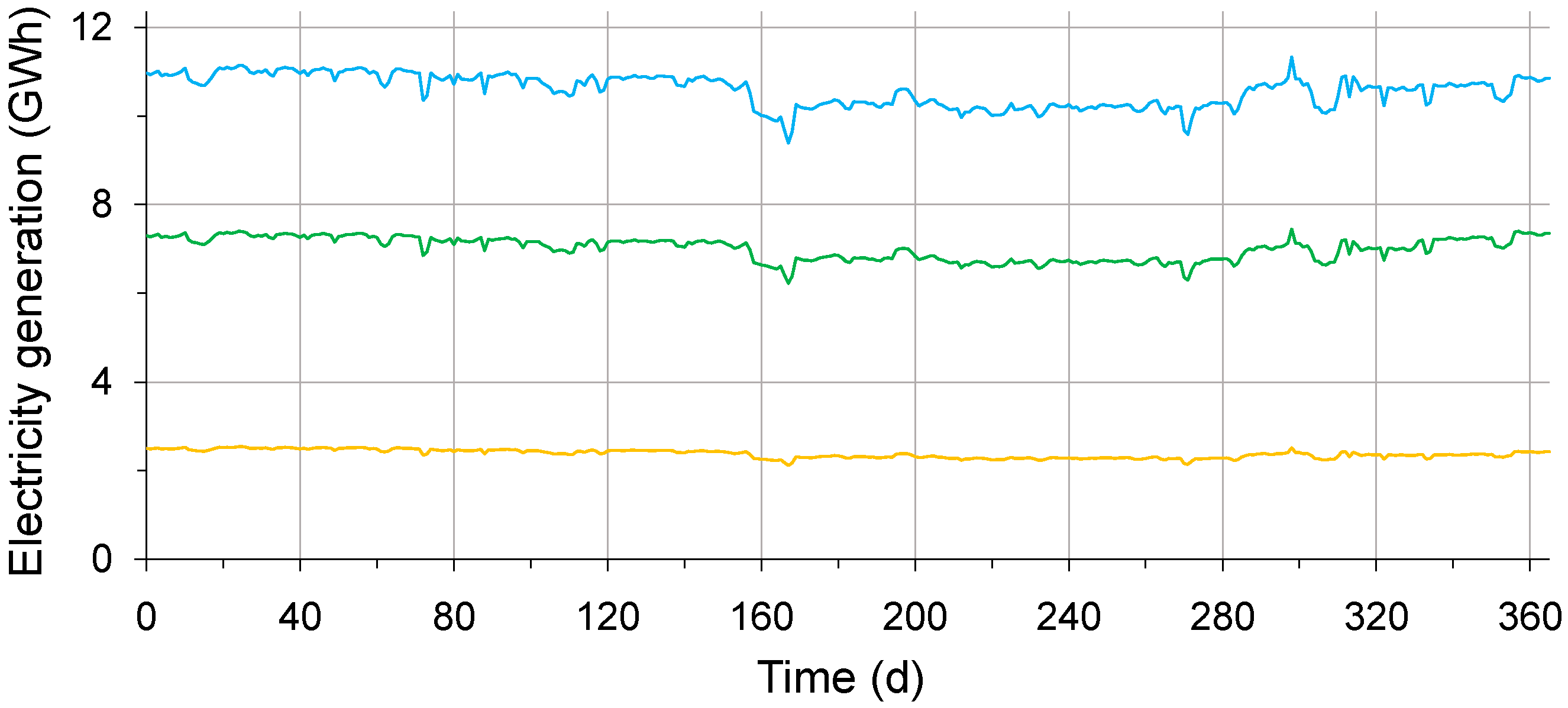
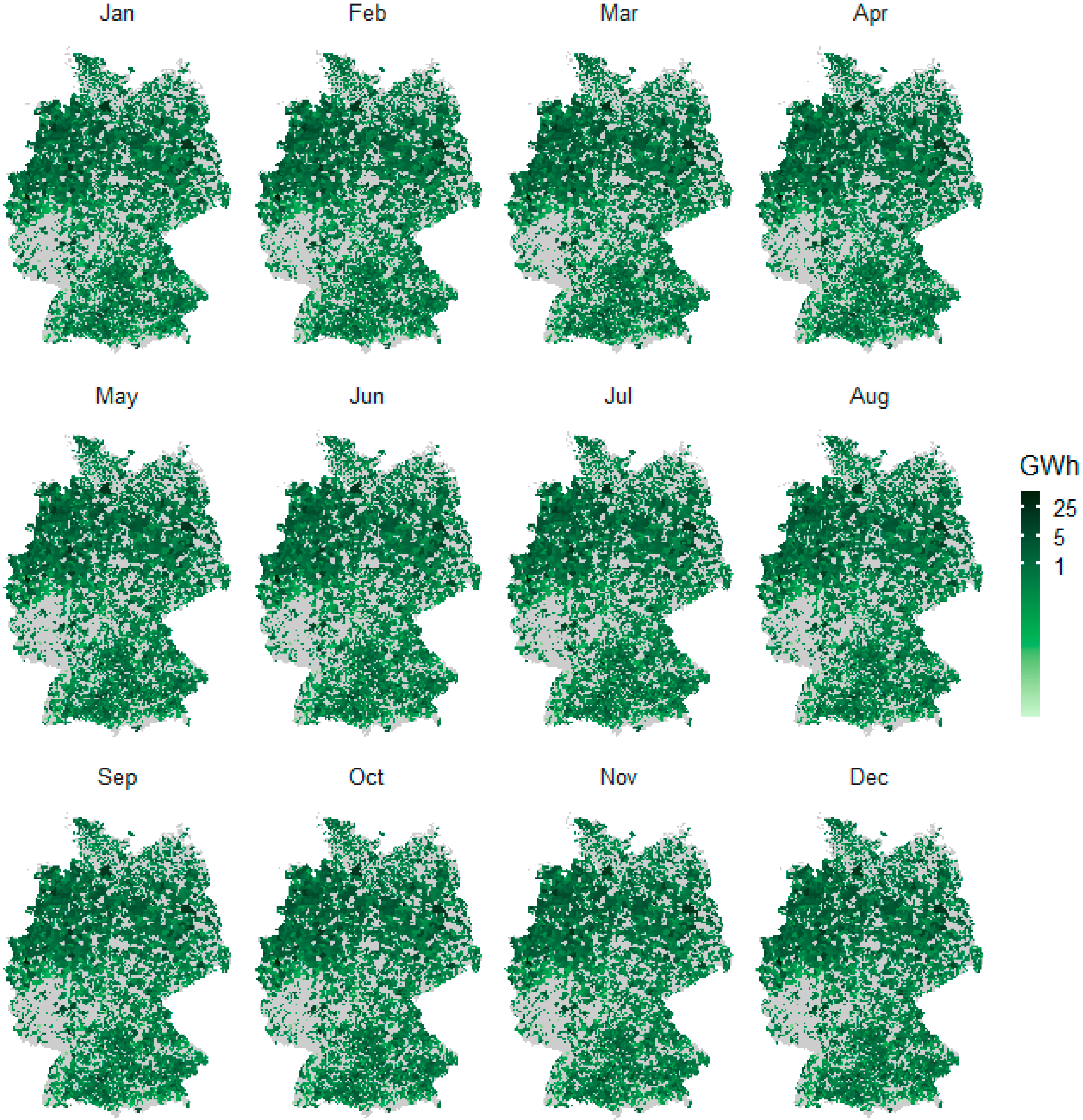
| Plant Data | Bioenergy Model |
|---|---|
| Latitude | used |
| Longitude | used |
| TSO region | used |
| Installed electricity capacity | used |
| Commission date | used |
| Decommission date | used (if existing) |
| Federal State | Capacity Factor (%) | Capacity Density (kW/km2) |
|---|---|---|
| Hamburg | 53.6 | 57 |
| Berlin | 53.6 | 46 |
| Lower Saxony | 51.7 | 37 |
| Schleswig-Holstein | 50.9 | 36 |
| North Rhine-Westphalia | 51.8 | 32 |
| Bremen | 53.6 | 30 |
| Bavaria | 52.0 | 25 |
| Baden-Württemberg | 51.9 | 24 |
| Saxony-Anhalt | 52.5 | 23 |
| Thuringia | 53.1 | 18 |
| Mecklenburg-Western Pomerania | 52.2 | 17 |
| Brandenburg | 52.6 | 16 |
| Saxony | 52.4 | 16 |
| Hesse | 52.5 | 14 |
| Rhineland-Palatinate | 52.1 | 10 |
| Saarland | 53.6 | 4 |
Disclaimer/Publisher’s Note: The statements, opinions and data contained in all publications are solely those of the individual author(s) and contributor(s) and not of MDPI and/or the editor(s). MDPI and/or the editor(s) disclaim responsibility for any injury to people or property resulting from any ideas, methods, instructions or products referred to in the content. |
© 2025 by the author. Licensee MDPI, Basel, Switzerland. This article is an open access article distributed under the terms and conditions of the Creative Commons Attribution (CC BY) license (https://creativecommons.org/licenses/by/4.0/).
Share and Cite
Lehneis, R. The Electricity Generation Landscape of Bioenergy in Germany. Energies 2025, 18, 1497. https://doi.org/10.3390/en18061497
Lehneis R. The Electricity Generation Landscape of Bioenergy in Germany. Energies. 2025; 18(6):1497. https://doi.org/10.3390/en18061497
Chicago/Turabian StyleLehneis, Reinhold. 2025. "The Electricity Generation Landscape of Bioenergy in Germany" Energies 18, no. 6: 1497. https://doi.org/10.3390/en18061497
APA StyleLehneis, R. (2025). The Electricity Generation Landscape of Bioenergy in Germany. Energies, 18(6), 1497. https://doi.org/10.3390/en18061497







